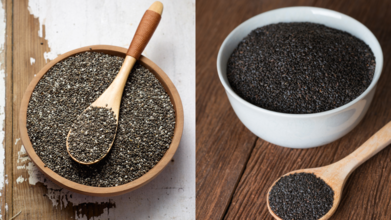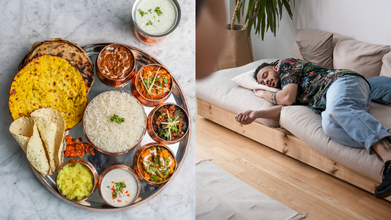- Health Conditions A-Z
- Health & Wellness
- Nutrition
- Fitness
- Health News
- Ayurveda
- Videos
- Medicine A-Z
- Parenting
- Web Stories
Guilt-Free Valentine’s Day Treats That Won’t Mess With Your Weight Or Blood Sugar

Image Credit: Canva
Valentine's Day is all about indulgence, particularly of love, pampering and relationships but what we want you to focus on is the sweet kind- desserts. And if you're health-conscious, it can seem like a sugar minefield, with all the chocolates, the jelly filled cakes, drinks and more. The good news? You don't have to drop your wellness or fitness resolutions to indulge in love. With a little imagination and some savvy ingredient substitutions, you can have rich treats without the remorse. Here are some tasty, health-friendly Valentine's Day desserts that will indulge your sweet tooth without affecting your weight and blood sugar levels.
Classic Valentine's Day treats tend to be loaded with refined sugar and unhealthy fats, which can lead to blood sugar spikes and sabotage weight control efforts. But by substituting natural sweeteners, fiber-rich foods, and protein-rich alternatives, you can make desserts that are rich in taste but gentle on your body.
While sugar-free sweeteners such as stevia and monk fruit are wonderful substitutes, there are some artificial sweeteners that can result in digestive discomfort. Opt for natural ones and pay attention to how your body tolerates them.
Valentine's Day is all about love, joy, and celebration—and that includes celebrating yourself! Just choosing the healthier options, you can have the holiday guilt-free and setback-free. No matter if you are celebrating with your partner, friends, or celebrating self-love, these healthy desserts will make your Valentine's Day sweeter than ever, without the sugar crash. So go ahead and make your favorite treat, enjoy every last bite, and celebrate love in all its colors.
Each of the following treats is formulated to balance flavor and nutrition, with heart-healthy fats, antioxidants, and proteins to help curb cravings.
Decadent But Healthy Valentine's Treats
1. Dark Chocolate-Dipped Strawberries
Chocolate and strawberries are a Valentine's Day classic, and this one is simplified while remaining healthy. Use 70% dark chocolate or more to get the most antioxidants and least amount of sugar. Melt the chocolate, dip fresh strawberries, and let them harden on parchment paper. The outcome? A sweet, fiber-filled treat that's satisfying without the crash.
2. Greek Yogurt Parfaits
Creamy Greek yogurt with high protein content serves as a rich and comforting dessert. Top it off with fresh berries and a sprinkle of nuts or granola for crunch. Greek yogurt contains probiotics that promote gut health, and the fruit adds natural sweetness without overusing sugar.
3. Protein-Rich Mug Cakes
For a hot, single-serving treat, combine protein powder, almond flour, cocoa powder, and almond milk in a mug. Microwave for about one minute, and you're enjoying a silky, chocolate-flavored cake that contains a few hundred calories rather than thousands of the old-style kind. The treat provides an added protein jolt without messing with blood sugar levels.
4. Superfood Chocolate Bark
Melt dark chocolate and coat a baking sheet with it thinly. Top with your preferred almonds, walnuts, chia seeds, or dried cranberries. Allow to set and break into pieces. The antioxidant-dense snack is simple to prepare and filled with healthy fats and fiber.
5. Low-Sugar Energy Bites
Combine rolled oats, nut butter, a drizzle of honey, and dark chocolate chips. Roll into small balls and refrigerate. These no-bake bites provide a quick energy boost, thanks to the perfect balance of healthy fats, protein, and fiber.
6. Heart-Shaped Rice Cakes with Toppings
Shape rice cakes into hearts with a cookie cutter and top them with almond butter, sliced banana, or cinnamon sprinkles. This is an easy and light option that works for both children and adults.
7. Sugar-Free Hot Cocoa
Warm up with guilt-free hot cocoa by blending unsweetened cocoa powder, almond milk, and a natural sweetener such as stevia. A dash of vanilla extract adds an extra depth of flavor.
8. Banana "Nice" Cream
Combine frozen bananas with a splash of almond milk and a few drops of vanilla extract and blend until smooth. For chocolate, add a tablespoon of cocoa powder. This naturally sweet, creamy ice cream substitute contains no added sugars or artificial ingredients.
9. Homemade Nut Clusters
Sprinkle with roasted almonds, cashews, and pecans, and top with melted dark chocolate. Allow them to harden in clusters for a crunchy, nutrient-rich snack.
Tips to Stay-On-Track with Your Fitness Goals
- If you know you will be with temptations all around you, prepare your own healthier snacks ahead of time. This way, you won't feel denied or tempted to overindulge.
- Savor each bite instead of rushing through your treat. Appreciate the flavors and textures, and listen to your body’s signals to avoid overeating.
- Rather than saying no to sweets altogether, enjoy smaller portions of your favorite treats. A piece of dark chocolate or a few bites of a homemade dessert can be just as satisfying as an entire slice of cake.
- Balance indulgence with exercise. Whether a couple's exercise routine, a quick walk, or dancing, exercise keeps cravings and energy in check.
- Staying hydrated by drinking lots of water can avoid confusing thirst with hunger. Similarly, good sleep also regulates hunger hormones, lowering cravings for sweet treats.
Chia Seeds vs Sabja (Basil) Seeds: How They Differ in Health Benefits

Chia seeds and sabja seeds may look similar, but they offer very different health benefits. While both are packed with nutrients and easy to include in your daily diet, choosing the right one depends on your specific health needs, whether it is improving digestion, managing cholesterol, or boosting protein intake.
Here is a closer look at how they compare and what each seed can do for your body.
Chia Seeds
They are a powerhouse of Omega-3 fatty acids, which play a crucial role in reducing inflammation and protecting your heart. That means if your diet is looking a little too oily or your cholesterol numbers are not looking good, chia can be a new good thing for your heart.
Chia seeds are a complete protein; they contain all nine essential amino acids your body cannot make on its own. That is rare in the plant world. Compared to sabja (basil) seeds, chia packs in more protein per serving, making it an ideal option for vegetarians or anyone looking to level up their protein intake without touching a protein bar that tastes like cardboard.
Chia seeds are also a great source of micronutrients--magnesium, copper, selenium. These nutrients do not just sound healthy; they help with blood sugar regulation and energy production and may even support diabetes management.
Sabja (Basil) Seeds
Sabja seeds (also known as basil seeds) are cooling by nature; they are your go-to during the sweaty summer months or when your gut is acting up.
Feeling bloated, constipated, or trapped in a never-ending acidity cycle? Sabja has your back. It is rich in fibre, which helps keep your digestion smooth, your tummy calm, and your gut bacteria dancing.
But do not dismiss sabja as just another seed. It is loaded with flavonoids and polyphenols, two antioxidant groups that fight inflammation and protect your skin. So if you are breaking out more than usual, sabja could help you cool down from the inside out.
And yes, it is especially loved in Ayurvedic traditions for helping with acne, skin irritation, and generally bringing a calming effect to the body.
Chia vs Sabja
Here is a quick reality check: they are both great, but for different reasons.
Chia has omega-3 fatty acids.
Chia has complete protein.
Chia has micronutrients (magnesium, selenium, etc.).
Sabja offers digestive support (constipation, gas, acidity).
Sabja offers an antioxidant punch.
Sabja offers acne-fighting benefits.
How to Use Them
Chia: Add it to smoothies, puddings, or overnight oats. Soak them in water or almond milk for at least 30 minutes to avoid the dreaded chia belly.
Sabja: Best soaked in water for 10-15 minutes. Use in lemon water, faloodas, rose milk, or just sip throughout the day as a cooling tonic.
You do not have to pick sides. Some days you will need the heart-helping, protein-rich punch of chia; other days, your body will crave the calm, gut-soothing embrace of sabja. Balance is key. Let chia handle your protein goals and sabja soothe your stressed skin and stomach.
Celebrity Nutritionist Shares 2 Foods For Lunch That Help Avoid Afternoon Slump

If lunch leaves you ready to pass out face-first on your keyboard, you are not alone. That dreaded afternoon slump is as real as that 4 pm coffee craving. It hits hard, dragging you into a state of foggy fatigue, irritability, and desperate tea breaks. But according to celebrity nutritionist Rujuta Diwekar, there is a surprisingly simple way to dodge this daily crash, and it starts with your lunch plate.
Diwekar, who works with stars like Kareena Kapoor, Alia Bhatt, Varun Dhawan, Saif Ali Khan and Karisma Kapoor, recently shared on Instagram two old-school yet powerful food additions that could keep you alert, happy, and fully functional post-lunch.
Afternoon slump means sleepiness. It feels like if you do not have tea, coffee or a cigarette, you will go into a coma. Sounds relatable? Absolutely. Diwekar also says that many people become cranky or snappy after lunch, and it is no coincidence. In fact, she jokes that some office meetings are strictly scheduled before lunch because nobody wants to deal with a post-meal grump.
But if you want to avoid that post-lunch crash, Diwekar recommends making two key additions to your midday meal: ghee and chutney.
1. Why Ghee
Yes, that ghee. The very ingredient many of us banished from our diets in the name of weight loss. “A lot of people tell me they have been putting on weight over time, or they are dealing with issues like thyroid imbalance or pigmentation,” says Diwekar. “Some even struggle with stubborn constipation and spend more time in the bathroom than they would like to admit.”
However, she advises bringing ghee back. A teaspoon of ghee in your lunch can be a game-changer. It helps with:
- Absorbing fat-soluble vitamins like D and B12
- Balancing hormones and supporting thyroid health
- Improving gut function and digestion
- Nourishing the skin from within
- Boosting energy levels naturally
Ghee provides slow-release energy, meaning your body does not go into a crash-and-burn cycle post digestion. Instead, you feel energised, calm and less likely to reach for sugar, caffeine, or cigarettes.
2. Why Chutney
Not ketchup or mayo. She is talking about real chutney, the kind your mum or grandmother probably made from scratch. “The second thing that needs to be part of your lunch is any kind of chutney,” says Diwekar. “We make coconut chutney, curry leaves chutney, lentil chutney, flaxseed chutney. There are so many chutneys in our collective cuisine.”
And it is not just about taste. These spicy, tangy, herby blends are packed with micronutrients, fibre and digestive enzymes that aid in the smooth breakdown of your food. They help prevent bloating, keep your gut flora happy and add a fresh zing to your plate.
Here are some great options:
- Coconut chutney: cooling, rich in good fats
- Curry leaf chutney: great for iron and hair health
- Flaxseed chutney: high in omega-3 and fibre
- Lentil chutney: protein-packed and grounding
Diwekar's core message is clear: health does not have to mean salads and smoothies. There are solutions sitting right in our kitchens. Instead of obsessing over complicated meal plans or imported ‘superfoods’, just eat in tune with traditional wisdom. The combination of ghee and chutney is centuries old, and it still works. A drizzle of ghee and a dollop of chutney might be all it takes to keep you breezing through your afternoon without the slump.
Anti-Allergy Diets: Dietician Reveals How To Naturally Build Immunity Through Nutrition

Credits: Canva
Allergies are more common than ever with nearly 6% of adults and children in the US have some form of food allergy, and that number continues to rise. Whether it’s a peanut reaction, seasonal sneezing, or unexplained flare-ups after certain meals, allergies are increasingly linked to the immune system’s overreaction. And here’s where it gets interesting, your diet might be the missing link—not just in managing symptoms, but in preventing them in the first place.
The mainstream response to allergies often begins and ends with antihistamines but according to certified dietitian Lavleen Kaur, healing starts from within, “Allergies—whether triggered by food, weather changes, or environmental factors—are signs of an overactive immune system. True healing begins from within. Building natural immunity through nutrition is a long-term, sustainable approach that not only helps prevent allergic flare-ups but also strengthens overall health.”
Expert dietician reveals how your food and lifestyle choices can shape your immune response—and how a few shifts could help you reduce allergic reactivity naturally.
Immune System Starts in the Gut
Roughly 70% of your immune system lives in your gut. This isn’t just an interesting stat—it’s the reason nutrition plays such a central role in how your body handles allergens. A gut that’s inflamed, leaky, or dominated by bad bacteria is more likely to misfire, reacting to harmless proteins in food or the environment.
Kaur emphasizes the importance of nurturing this digestive-immune connection: “When the digestive system is strong, the immune system becomes less reactive. That’s why I often say, ‘Immunity begins at home’—not through expensive supplements, but through simple, consistent habits rooted in traditional wisdom.”
Start Your Day with Immunity-Boosting Rituals
Forget the hype around complicated health tonics. According to Kaur, the day should start with an old-school combination that’s surprisingly effective: one fig, two dates, and 3–4 black raisins, soaked overnight. “This combination is rich in iron, helps build stamina, and keeps oxygen flowing efficiently in the body,” she says.
Follow that up with probiotic-rich foods like curd, fermented kanji, or buttermilk. These naturally populate your gut with beneficial bacteria, improve digestion, and enhance immune balance.
Hydration is another non-negotiable. “Pale-yellow urine is a sign you’re well-hydrated,” says Kaur. She recommends rotating plain water with coconut water, herbal teas, and turmeric-ginger infusions—especially during allergy season, when respiratory health is easily compromised.
Eat with the Seasons, Not the Supermarket Shelf
There’s a reason your grandmother swore by seasonal eating. Fresh, in-season produce isn’t just better for the planet—it’s better for your immune system. Kaur urges people to “fill your plate with a rainbow of seasonal fruits and vegetables, especially those high in vitamin C like amla, guava, oranges, and bell peppers.”
Another group of nutrients to focus on? Quercetin and omega-3 fatty acids. Quercetin—a powerful antioxidant found in apples and onions—helps modulate the body’s histamine response, meaning fewer flare-ups. Omega-3s from flaxseeds, walnuts, and chia seeds work at the cellular level to reduce inflammation and balance immunity.
Gut Rituals that Support Allergy Relief
Beyond meals, Kaur recommends ancient digestive practices that keep the gut calm and efficient. After meals, chew a small amount of fennel seeds, cardamom, or clove with jaggery. This supports digestion and prevents the post-meal sluggishness that can signal immune stress.
At bedtime, her go-to ritual is a glass of warm turmeric milk. Turmeric is anti-inflammatory, and combining it with milk (or a plant-based alternative) enhances absorption. This simple step not only improves sleep but supports overnight cellular repair and immune regeneration.
Identify Your Real Triggers
What derails your immunity faster than pollen season? Ultra-processed foods. Refined sugar, deep-fried snacks, chemical additives, and preservative-laden packages are well-known immune suppressors. These foods also disrupt gut flora and increase inflammation, making your system more reactive.
Some people may benefit from limiting gluten or dairy, especially if allergies persist despite clean eating but Kaur cautions that elimination should always be done under guidance. “Removing a food group without support can lead to deficiencies. The goal is to reduce inflammation—not create new problems.”
Ancient Ayurvedic Ways To Relive Allergy
Modern medicine isn’t the only tool available for allergy relief. Kaur encourages integrating Ayurvedic practices like:
- Udvartan (herbal dry massage) for detoxifying the skin
- Nasya therapy (medicated nasal drops) for clearing the sinuses and balancing the mind
- Shirodhara (streaming warm oil over the forehead) to regulate nervous system sensitivity
These therapies support the body's natural detox processes and promote systemic balance—especially helpful for those with chronic skin, respiratory, or seasonal allergies.
If you’re looking for a magic pill or a shortcut, nutrition-led immunity might disappoint you. But if you’re after something sustainable, preventive, and empowering, this approach could change your life.
Building a stronger immune system isn’t about perfection. It’s about consistency. Kaur puts it simply: “When the body is nurtured consistently through nutrition and lifestyle, it becomes less reactive, more resilient, and deeply aligned with nature.”
In a world overflowing with medications, allergy shots, and crisis responses, the anti-allergy diet offers a grounded, proactive path—one meal, one habit, one day at a time.
Allergies don’t have to control your life. By rethinking your plate, daily rituals, and how you support your gut, you can create an environment where your immune system works with you—not against you. Nutrition won’t replace your EpiPen, but it might help you reach for it less often and that’s worth chewing on.
Lavleen Kaur is the Chief Dietitian & Founder, Santushti Holistic Healthcare & Diet Insight Nutrition Academy
© 2024 Bennett, Coleman & Company Limited

